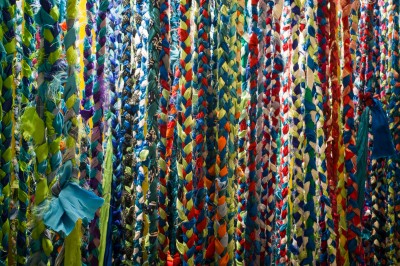Białka’s Braids
Audio description (in Polish)What are Białka’s braids? What does Cecylia Malik’s work look like? Listen to the audio description.

In the 28th issue of our online magazine, we remain in the sphere of education, albeit seen from a more environmentalist-cum-activist angle. First, we are going to revisit the exhibition Two Arts Are Better Than One and Cecylia Malik’s Białka’s Braids.
How did the artist’s daughter, Urszula, answer the question “Who is your mom?” – “My mom is an artist and activist. She does a lot of things, paints pictures, makes films, and defends historic buildings. She works with many environmentalists and together with them fights against river regulation, development/unfair zoning of Zakrzówek (a quarry reservoir in Kraków, where we all bathe in the summer), and tree cutting. I feel that in recent years my mother has been particularly involved in organizing ecological actions and demonstrations, but each of them is an artistic concept of high aesthetic value. Mom has a talent for bringing people together to create something together. Apart from that, she conducts many workshops and presentations to raise awareness of environmental issues, and recently she has even written a children’s book about trees.”
During last year’s exhibition for children and parents, wicker bases were placed in Małachowskiego Square, the output of a workshop organised by Jaśmina Wójcik and her daughters – Zoya and Lea. We recall the artist’s earlier “wicker” project carried out with Jacek Gadek on the terrace of the Zachęta Project Room in the summer of 2015. Huts made of unbarked, natural wicker became a place where Warsaw inhabitants could come and hide, smell the natural environment of the Vistula and its climate, relax, and rest for a while.
The nature theme also appeared in the programme accompanying the exhibition Gardens (2015). Listen to the recording of the meeting with biologist and mycologist Dr Marta Wrzosek, during which we talked not only about fungi – the main “protagonists” of the installation by Iza Tarasewicz made in the space of the Zachęta’s old staircase.
The latest issue cannot overlook works from our collection. Katarzyna Kozyra’s Animal Pyramid is already an iconic work of critical art. It is still relevant today as a powerful commentary on our attitude toward animals. Anna Molska’s film Sixth Continent was made specially for the artist’s solo exhibition in 2012 (curator: Joanna Kordjak). The three-channel video installation was inspired by the early scientific expeditions to Antarctica, in which the artist’s grandfather, Professor Janusz Molski, participated.
